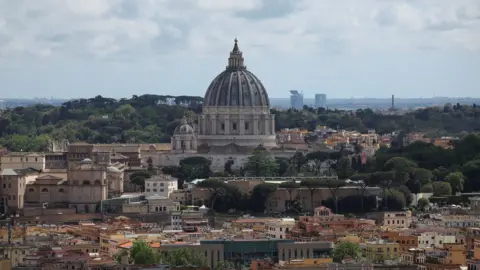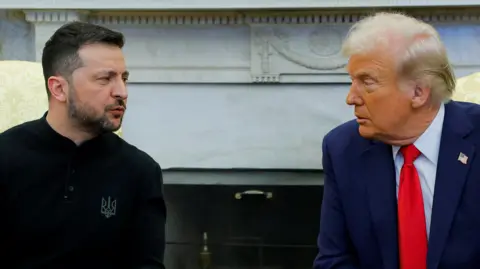 Reuters
ReutersWorld leaders can come together on Saturday to pay tribute to a statesman’s colleague whose church has more members than their states have citizens.
But they can also use the pope’s funeral as a rare and unexpected opportunity to lead an impromptu little diplomacy.
Because it will be one of the largest gatherings of heads of state and world government since the funeral of the end of the queen in 2022.
The diplomats said that there were few plans for official meetings between government leaders because it would not be in the minds of what is a solemn opportunity.
“We do not want to be disrespectful towards our hosts,” said a European diplomat. “But will there be opportunities for Brush-Bys? Absolutely.”
It was a reference to the fortuitous conversations which can take place on the sidelines of a summit or a ceremony while the leaders “brush each other while they find their seats.
Another official said: “It’s a burial. We are walking carefully.”
All eyes will, of course, if presidents Trump and Zelensky take advantage of the opportunity to be in the same place to discuss the prospects of a cease-fire in Ukraine. They will be seated in an area of Saint-Pierre allocated to world leaders in alphabetical order by country.
You might imagine that it means that leaders of the United States and Ukraine would sit close to each other. But French was historically the language of diplomacy, so the president of the United States could well be at a certain distance from his Ukrainian counterpart.
Given the tensions between the two leaders, some diplomats said it could be a bad thing and could avoid the risk of confrontation like this in the Oval office in February.
It is possible that the two men can meet privately elsewhere in Rome, as some European countries hoped. “If that happens, it will be impromptu,” said a diplomat.
On Tuesday, Zelensky said he was ready to see Trump in Rome. “We are always ready to meet our partners from the United States of America,” he said.
The next day, Trump said that he had “organized many meetings” but did not say with whom. The presence of Zelensky was initially in doubt following the last Russian strikes on kyiv, but his arrival in Rome was confirmed by a spokesperson for the Ukrainian presidential election on Saturday.
 Reuters
ReutersThe diplomatic emphasis will be from Saint-Pierre where the presidents and the Prime Ministers, Princes and Monarchs will sit while waiting for the obquators to begin. It will be the main opportunity for them to get involved and discuss the questions of the day, create contacts and establish relationships.
The trip to Rome could also offer an opportunity for diplomatic meetings. The Vatican said that 170 delegations came, of which around 50 heads of state, 15 heads of government and 12 ruling monarchs. The chances they meet in one of the two airports in Rome on arrival or departure are high.
But while funeral can present diplomatic opportunities, they can also constitute threats. There is the possibility that the leaders come into contact with an opponent. Indeed, politicians subject to European travel sanctions can visit the city of Vatican because it is considered a neutral territory. Above all, neither the president Vladimir Putin of Russia, nor the President Xi Jinping of China must attend.
- You can watch and follow the funeral live here on the website and the application of the BBC News. In the United Kingdom, there will be live coverage on BBC One from 0830 to 1230 BST, presented by Reeta Chakrabarti, available to look at the iplayer. There will also be live coverage on the BBC News Channel Presented by Maryam Moshiri. Finally, you can also follow the funeral cover on the BBC World Service
The most unpredictable moment could come in the service itself. Francis Campbell, the British ambassador to the Holy See from 2005 to 2011, said that the funeral mass implies a moment when the celebrants give themselves a sign of peace and that the leaders could find themselves shaking the hand of people they prefer not. “You can’t avoid it,” he said. “You are witnessing a religious ceremony and it is up to you to participate as much as possible.”
During the funeral of Pope Jean-Jean-Paul in 2005, the prince of Wales of the time found himself unexpectedly with President Robert Mugabe of Zimbabwe. The future King’s future spokesperson said he was “caught by surprise”.
There are also risks for leaders who appear in front of several thousand people in mourning. During the same funerals in 2005, George Bush was hooked by the crowd when his face was displayed on an instructor, an apparent judgment on the war of the American president in Iraq.
 Getty images
Getty imagesFormer Prime Minister Harold Wilson is recognized to invent the expression “a good work funeral” in relation to the service marking the death of Winston Churchill in 1965.
Geoff Berridge, professor emeritus of international relations at the University of Leicester, said that funerals that were of considerable value.
“They provide heads of state and government a good excuse to break the existing schedules for urgent discussions on current problems without exciting the expectations of the public,” he wrote in his book, Diplomacy: Theory and Practice.
In recent years, there have been several of these funerals after the death of the late Queen, the former Japanese Prime Minister Shinzo Abe and Ebrahim Raisi, the Iranian president.
But the “work funeral” have also been satire. Jim Hacker, the eponymous PM in the yes, the Prime Minister’s comedy on the BBC, said that the working funerals were a “paradise sent” opportunity.
“Digneous sorrow drops very well with voters, especially when shared by statesmen of the world,” he told his collaborators. The funeral working was “much better than a summit because there is no expectation. People do not expect their leaders to return from funeral with test prohibition agreements or reductions in agricultural quotes. We can therefore have significant discussions. A summit is only a circus of public relations.”



